|





Editorial
|
Fragments
|
Cahokia II
|
Piasa Creature II
|
Sphinx III
Register
for our Hall of Records Newsletter!
Questions? Comments? Suggestions? Advertising? Press Releases?
Contact us!
The Mysterious Piasa Creature Part I
|
Part II
|
The Fabulous Thunderbird

|
|
One of the oldest engravings showing the Piasa creature. From Henry Lewis,
Das Illustrierte Mississippithal, (Dusseldorf, 1854.) The engraving
of the creature is at the lower right, and appears to be more of an imaginative
artistic embellishment than an accurate rendering. (See below for a more
accurate and detailed rendering of the creature.)
|
 n 1673, seven explorers set out by canoe from the French colonies in Canada to search for a waterway
to the Pacific Ocean. They did not discover a passage to the western sea, but they did find something
bizarre and puzzling — a mystery that remains to this day.
n 1673, seven explorers set out by canoe from the French colonies in Canada to search for a waterway
to the Pacific Ocean. They did not discover a passage to the western sea, but they did find something
bizarre and puzzling — a mystery that remains to this day.
The expedition encountered the mystery on the east side of the Mississippi River a short distance
upstream from present-day Alton, Illinois. There, on a limestone cliff above the east bank of the river,
the explorers found images of a strange creature painted in red, yellow, green, and black. A record
kept during their journey described the paintings as follows:
They are as large as a calf, with head and horns like a deer or goat; their eyes red; beard like a
tiger; and a face somewhat like a man. Their bodies are covered with scales. Their tails are so long
that they pass over their heads and between their forelegs, under their belly, and ending like a
fish tail.
A picture of these images in a book published in 1854 also showed wings and claws on one of them.
Although the explorers recognized the remarkable nature of the cliff paintings, they did not appear
to know their meaning.
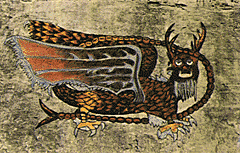
|
|
The 1934 restoration of the Piasa Bird on the bluff over the Mississippi near Alton,
Illinois, replacing the original which had been destroyed during quarrying operations
in the 19th century. This painting has since been replaced twice, the current version
having been put in place in 1998.
(See Part I)
|
Various interpretations of the paintings have been offered since the expedition of 1673. One of them
suggests the mysterious images can be explained by a legend about a large, bird-like creature called
Piasa (pronounced PIE-a-saw). According to the legend, Piasa lived in a cave in the cliff above the
Mississippi. Whenever it hungered, it swooped down, attacked, and devoured its prey. Some of its
victims were human. Eventually, inhabitants of the area destroyed the monster and painted its likeness
on the cliff to commemorate their victory.
Although this legend is thought-provoking, by itself it is only scant evidence that the Piasa creature
was real. A more convincing argument for its existence could be made if there were additional accounts
of this kind of animal. If Piasa did exist, there should also be stories about its ancestors and,
perhaps, of its contemporaries and descendants.

|
|
The many-headed "Lernean Hydra", slain by Heracles (Hercules) in the Greek myths.
|

Within the category of bizarre creatures, there are a number of accounts of animals that were similar
to Piasa. These animals, which were reptilian in nature, seem to have lived throughout the world from
remote antiquity to the present time.
Some of the oldest accounts of Piasa-like creatures come from Europe and Asia. One of them is found in
Greek mythology and tells of a battle between Hercules and a monstrous reptile called Hydra. The ancient
Greeks named this kind of animal derkein, which became "dragon" in the English language.
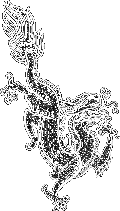
|
|
Classic "Lung" type Chinese dragon.
|
Chinese mythology is loaded with references to dragons, which are still revered even today by the Chinese
as the wisest and strongest of creatures. An interesting description of a Chinese dragon can be found in
the Pan Tsao Kang Mu, a collection of ancient Chinese writings about medicinal substances:
It has a head like a camel, horns like a deer, ears like a bull, eyes like a devil, scales like a carp,
claws like an eagle, and it has whiskers on each side of its mouth.
A comparison of this description with the description of the Piasa paintings points to some remarkable
similarities between the two.
Dragons similar to Piasa also appear in the 5th century a.d. legend of Siegfried and the 8th century a.d.

|
|
A classic European-style red dragon.
|
Anglo-Saxon epic poem of Beowulf. Other Piasa-like reptiles were reported in 1349 and 1725. The former
described an encounter between a knight named Gozione and a dragon on the Mediterranean Island of Rhodes.
This animal was the size of an ox with ears like a mule, eyes sparkling as though flashing fire, sharp
teeth, claws, a body covered with scales, and a tail like a crocodile. It also had two wings, which were
blue on top but blood-colored and yellow below.
A report in 1725 related an event which occurred some 14 miles from Jerusalem. On November 15th of that
year, a dragon was destroyed after it had killed and eaten several cattle and men. The dragon was as
large as a horse with horns like a bull, head like a lion, and beak like an eagle. It also had teeth, a
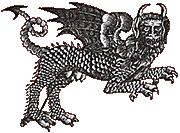
|
|
The "Terrible Wild Monster" sighted near Jerusalem in 1725. Note the close similarity to
the Piasa creature photo above.
|
body covered with scales, wings, and a tail 4-1/2 feet long.
Reports of reptilian creatures resembling Piasa started to change somewhat after the 1700s. Developments
in science began to encourage objective observation and introduced new terms to describe what was seen.
Descriptions of natural phenomena were no longer as dependent upon traditional terminology or stylized
verbiage or as subject to personal embellishment as they had been. And words, such as "dragon", were
replaced by scientific names.
A more scientific approach appears to have been used to describe a Piasa-like creature seen during the
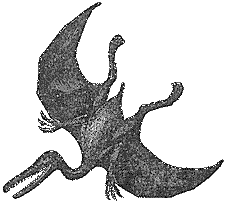
|
|
Pterodactyl, native to the Jurassic Period (140 million — 190 million years ago).
|
winter of 1856 in northeastern France. There, in a partly completed railway tunnel, workmen watched in
amazement as a bizarre animal appeared to emerge from a large limestone boulder they had just split open.
The creature stumbled toward them on four leg-like limbs, made a croaking sound, fluttered its wings, and
died at their feet. The animal had sharp teeth, long talons, and a wingspan of more than ten feet. In an
earlier age, this creature might have been called a dragon. In 1856, however, a student of paleontology
identified it as a large, winged reptile known as a pterodactyl.
Regardless of whether this animal actually came out of the boulder or had simply sought refuge behind it
in the relative warmth of the tunnel, its presence was evidence of the existence of a Piasa-like creature
- one that had been born in either ancient or modern times.
Another Old World encounter with a Piasa-like creature occurred on a morning in 1986 on the Mediterranean
Island of Crete. There, three hunters witnessed a huge, bird-like animal gliding a short distance above
the ground. Its beak was similar to a pelican's, its wings seemed to be made of membranes with finger-like
protrusions, and its hind legs had long, sharp claws. As the men watched, the creature flew away into a
mountainous area and disappeared. When the hunters returned home, they looked through several books for a
picture of the bizarre animal. They found that it closely resembled a pterodactyl.

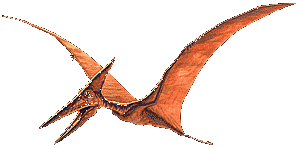
|
|
Pteranodon, native to the Mesozoic Period (65 million — 230 million years ago).
|
There have also been a number of accounts of Piasa-like creatures in North America. And, like their Old
World counterparts, some of the stories appear to be very old. Perhaps the oldest accounts are found in
the myths of the Plains Indians. One of these myths tells of a huge, dark animal with wings and a long beak.
Another speaks of a monster that lives beneath bluffs along the Mississippi River. And there is an old
drawing of a strange creature that closely resembles Piasa. Each of these accounts appear to describe a
different aspect of a Piasa-like creature.

|
|
Above left: Winnebago "spirit animal", which the Winnebago Indian shamans claimed to see
while in a trance state.
Above right: "Mythic wild cats" of the Ojibway Indians. All of these animals have essentially
the same characteristics as the Piasa creature, though these images originated hundreds of miles
away.
|
A more recent story about this kind of animal came out of a Plains state in the summer of 1873. There, on
a northeast Texas farm five miles from Bonham, several men stared in awe at an enormous reptilian animal as
it flew slowly overhead.
Similar sightings continued into the 20th century. Two of them occurred in early 1976 in southern and
south-central Texas, respectively. The first took place during the evening of January 14 in Raymondville.
There, a man was attacked by a large, featherless flying creature that swooped down on him in the backyard
of a relative's home. The creature was as big as a man and had huge red eyes, large claws, and a wingspan
of 10 to 12 feet. Although the man's clothing was torn, he escaped unharmed, and the creature flew away.
A second sighting happened on February 24 near San Antonio. There, while driving to work, three school
teachers saw an enormous, low-flying, bird-like creature with a wingspan of nearly 20 feet. Later, they
remarked how much it looked like a pteranodon.
A third encounter occurred during the evening of July 25, 1977, in Lawndale, Illinois. Six people in this
central Illinois town saw an immense flying creature descend from the southwest, seize a ten-year-old boy
with its claws, and carry him some 35 feet before dropping him unharmed. The creature continued flying to
the northeast with a companion. Both of them had beaks about six inches long and wingspans of nearly ten
feet.
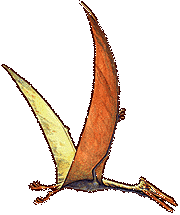
|
|
Quetzalcoatlus, native to the Mesozoic Period (65 million — 230 million years ago).
With its a wingspan of well over 30 feet, it is believed to be the largest flying
creature on earth in any period.
|

Accounts of Piasa-like creatures from many different times and places suggest this kind (species) of animal
did exist and still exists today. They also point to a possible link between Piasa, dragon, and pterodactyl.
The presence of a few differences in the descriptions of Piasa-like animals suggest that some of these
creatures may not have been related. However, it is important to point out that physical differences can
occur naturally within a given species. And some of these variations are simply the result of differences
in age, sex, and habitat.
Differences in the descriptions of the same kind of animal can also result from differences in human
observers and in the circumstances of their observations. In addition, the personal integrity, facility
with words, and memory of a given observer can also affect the accuracy and completeness of a description.
Finally, some differences are almost inevitable when a description is communicated over many generations
or translated into other languages.
With all of the potential for differences, it is not surprising that there were some variations in the
descriptions of Piasa-like creatures. On the other hand, it seems significant that there were so many
similarities, especially in the principal features of size, head, eyes, beak, teeth, wings, claws,
absence of feathers, etc. And it also appears significant that these features were essentially the same
for Piasa, dragon, and pterodactyl.
There is an intriguing question at this point. If, according to common belief, pterodactyl-like animals
became extinct millions of years ago, how could they have been seen throughout the world since then?
Perhaps an answer can be found by considering prehistoric global changes and places where these reptiles
have been reported in more recent times.
There is evidence of catastrophic geological change in the distant past in many places around the world.
It is possible that ancestors of pterodactyl-like creatures lived through this change because of their
ability to fly. And, perhaps, the survivors settled in areas that would turn out to be far from human
habitation. This could explain the presence of large flying reptiles today and their relatively infrequent
appearance throughout history.
It is interesting to note that contemporary sightings of these creatures indicate they do live in remote
areas. for example, the report of a pterodactyl-like animal in Crete in 1986 indicated it flew into a
mountainous area and disappeared. And this suggests where the flying reptiles seen from Texas to Illinois
may have come from.
One of the least-known areas in North America can be found in eastern Mexico. This remote mountainous
region, known as the Sierra Madre Orientale, is only some 200 miles from southern Texas. A line drawn from
these mountains to the northeast crosses southern and northeastern Texas, southwestern Illinois (the site
of the Piasa paintings), and central Illinois — all places where strange, winged animals have been
reported. The line continues from central Illinois toward the Great Lakes and perhaps to an unknown ending
somewhere in the far north. If the beginning of this line in Mexico represents the home of large, flying
reptiles, what does its end mean? Does this line indicate a migratory route? Do pterodactyl-like creatures
periodically leave eastern Mexico in response to some archaic instinct and follow and ancient flyway to
the northeast in search of nesting habitats that disappeared in some ancient cataclysm — areas that are
no longer suited to prolonged reptilian occupation?
Perhaps many of the large, flying reptiles reported in other places around the world can also be explained
in the same way. It may be that they too inherited instinctive behavior that was first ingrained in
ancestors that lived in a world vastly different from today. And thus they also may continue to leave
remote areas from time to time to seek lands and climates that vanished long ago.
While the accounts of Piasa-like creatures seem to indicate this kind of animal does exist, they also
generate many questions and much speculation. Therefore, it is unlikely that the entire matter can be
addressed to everyone's satisfaction until hard evidence becomes available.
Perhaps someday one of these strange animals will again take to the air and be seen following an ancient
pathway through the sky. And, if it can be studied sufficiently, new light may be shed on Piasa, dragon,
and pterodactyl. And, maybe, the mystery of the Piasa creature will at last be solved.
Find out more about the mysterious Piasa Creature and other mysterious creatures of the air
in Part III of the Piasa Creature series, to be published in the Fall 1999 edition of
Mysterious World.
* * *

The current depiction of the Piasa creature can be reached via the Great River Road in southwest
Illinois and is a short distance northwest of the city of Alton. For more information, stop at the
Alton Visitors Center at 200 Piasa Street, Alton, Illinois 62002, or call 1-800-258-6645, or 1-618-
465-6676. 

 The Legend of the Piasa Bird, hosted by Piasanet
The Legend of the Piasa Bird, hosted by Piasanet
The Mysterious Piasa Creature Part I
|
Part II
|
The Fabulous Thunderbird
Editorial
|
Fragments
|
Cahokia II
|
Piasa Creature II
|
Sphinx III
Register
for our Hall of Records Newsletter!
Questions? Comments? Suggestions? Advertising? Press Releases?
Contact us!



 Lost Cities of North and Central America
Lost Cities of North and Central America
David Hatcher Childress
Rating:
   
One of the popular "Lost Cities" series, this book is a must-have guidebook for mysterious
places in North and Central America.
This book received several good reviews
Click
here
to buy this book.
 Historic Illinois From The Air
Historic Illinois From The Air
David Buisseret
Rating:
   
Review — Booknews, Inc., April 1, 1991:
Buisseret (history of cartography, Newberry Library) uses some 300 color and
b&w aerial photographs, satellite images, rare historic illustrations, and maps to
recreate the story of Illinois over centuries of growth and change. The great
cartography draws attention to the not-so-great (though fascinating and
instructive) aerial and ground photos.
Click
here
to buy this book.
 Michigan: Off the Beaten Path
Michigan: Off the Beaten Path
Jim Dufresne
Whatever you do when you travel, get off the interstate. Who needs more bland rest stops and fast food? Get into the heart of things with Globe Pequot's Off the Beaten Path series. Devoted to travelers with a taste for the unique, this easy-to-use guide helps you discover the hidden places in Michigan that most tourists miss — unsung, unspoiled, and out-of-the-way finds that liven up a week's vacation, a day trip, or an afternoon.
Click
here
to buy this book.
The Jesuit Relations and Allied Documents : A Selection
(Carleton Library Science, 7)
S.R. Mealing, editor
Click
here
to buy this book.
Country Roads of Illinois
Marcia Schedler, Victoria Sheridan
Ramble through America's rural heartland on winding back roads leading to
mom-and-pop markets, roadside fruit stands, steam railways, and an endless
variety of out-in-the-country attractions. Each title explores 10 or more
meandering weekend tours as authors share their intimate knowledge of people,
places, and country life.
Click
here
to buy this book.
 40 Great Rail-Trails in Michigan, Illinois and Indiana
40 Great Rail-Trails in Michigan, Illinois and Indiana
Roger Storm (Editor), Susan Wedzel (Contributor), Mike Ulm (Cor), Karen-Lee Ryan (Contributor)
Click
here
to buy this book.


 Passion: Music for the Last Temptation of Christ
Passion: Music for the Last Temptation of Christ
Rating:
    
This CD received superb reviews (5 stars) and is personally recommended by the publisher.
(The background music on this page is from "In Doubt", the sixth track of this CD.)
Click
here
to buy this music.


AAA Illinois/Indiana/Ohio Tour Book. Heathrow, Florida:
AAA Publishing, 1997.
AAA Michigan/Wisconsin Tour Book. Heathrow, Florida:
AAA Publishing, 1997.
Austin, H. Russell. The Wisconsin Story. Milwaukee, WI:
The Milwaukee Journal, 1948.
Balesi, Charles J. The Time of the French in the Heart of
North America: 1673-1818. Chicago: Alliance Francaise, 1991.
Berlitz, Charles. World of Strange Phenomena. New York: Fawcett
Crest, 1988.
Berlitz, Charles. World of the Odd and the Awesome. New York:
Fawcett Crest, 1988.
Blashfield, Jean F. Awesome Almanac — Illinois. Fontana, WI:
B&B Publishing, Inc., 1993.
Buisseret, David. Historic Illinois From The Air. Chicago and
London: The University of Chicago Press, 1990.
Calkins, Carroll C. (Project Editor) Mysteries of the Unexplained.
Pleasantville, New York: The Reader's Digest Association, Inc., 1982.
Childress, David H. Lost Cities of North & Central America.
Stelle, IL: Adventures Unlimited Press, 1992.
Cirlot, J. E. A Dictionary of Symbols. New York: Dorset
Press, 1971.
Daily Herald. (Arlington Heights, IL) April 5, 1996.
DuFresne, Jim. Michigan Off The Beaten Path. Old Saybrook, CT:
The Globe Pequot Press, 1988, 1990, 1993.
Gill, Sam D. and Irene F. Sullivan. Dictionary of Native American
Mythology. New York and Oxford: Oxford University Press, 1992.
Gould, Charles. Mythical Monsters. London: Bracken Books, 1989.
Grant, Michael and John Hazel. Who's Who In Classical Mythology.
New York and Oxford: Oxford University Press, 1973.
Hammond Award World Atlas. Maplewood, NJ: Hammond Incorporated, 1967.
Kenton, Edna, ed. The Jesuit Relations and Allied Documents.
New York: Albert & Charles Boni, Inc., 1925.
Mallery, Garrick. Picture-Writing of the American Indians — Volume Two.
New York: Dover Publications, Inc., 1972.
Miller, Nancy K. "Tracking Pterosaurs," Earth, (October, 1997), 20, 21.
Schedler, Marcia. Country Roads of Illinois. Castine, ME:
Country Roads Press, 1992.
Storm, Roger and Susan Wedzel, Karen-Lee Ryan, Mike Ulm. 40 Great
Rail-Trails in Michigan, Illinois and Indiana. Washington, DC:
Rails-To-Trails Conservancy, Saturn Corp., 1994.
The Book of Knowledge, Books 1 and 18. New York: The Grolier Society,
Inc., 1942.
The Complete Books of Charles Fort, New York: Dover Publications,
Inc., 1974.
The World Book Encyclopedia, "I" — vo. 10, "M" — Vol. 13.
Chicago: Field Enterprises, Inc., 1973.
The WPA Guide To Illinois. New York: Pantheon Books, 1939, 1966, 1983.
Thompson, C. J. S. Giants, Dwarfs, and Other Oddities. New York:
Citadel Press, Carol Publishing Group, 1968.
|
